Introduction
Tenerife, the largest of the seven main islands of the Canary Archipelago, occupies a key position in the Atlantic Ocean. With its unique geographical position, the island attracts millions of tourists each year, offering a diverse landscape from high volcanic peaks to picturesque coastlines. Tenerife is about 300 kilometres from the northwest coast of Africa and about 1,300 kilometres from Spain, making it a strategically important and easily accessible destination.
This island is not only a tourist mecca, but also a place with a rich geological history, from its volcanic origins to its modern natural landscapes. Tenerife is a combination of high mountains, unique ecosystems and a dynamically changing climate, making it an ideal location for exploration and relaxation.
The importance of Tenerife in the context of geography and tourism cannot be underestimated, its unique geographical characteristics favour the development of different types of tourism and natural exploration. The island offers a wide range of natural and cultural attractions, making it one of the most attractive destinations in the world.
Geographical position
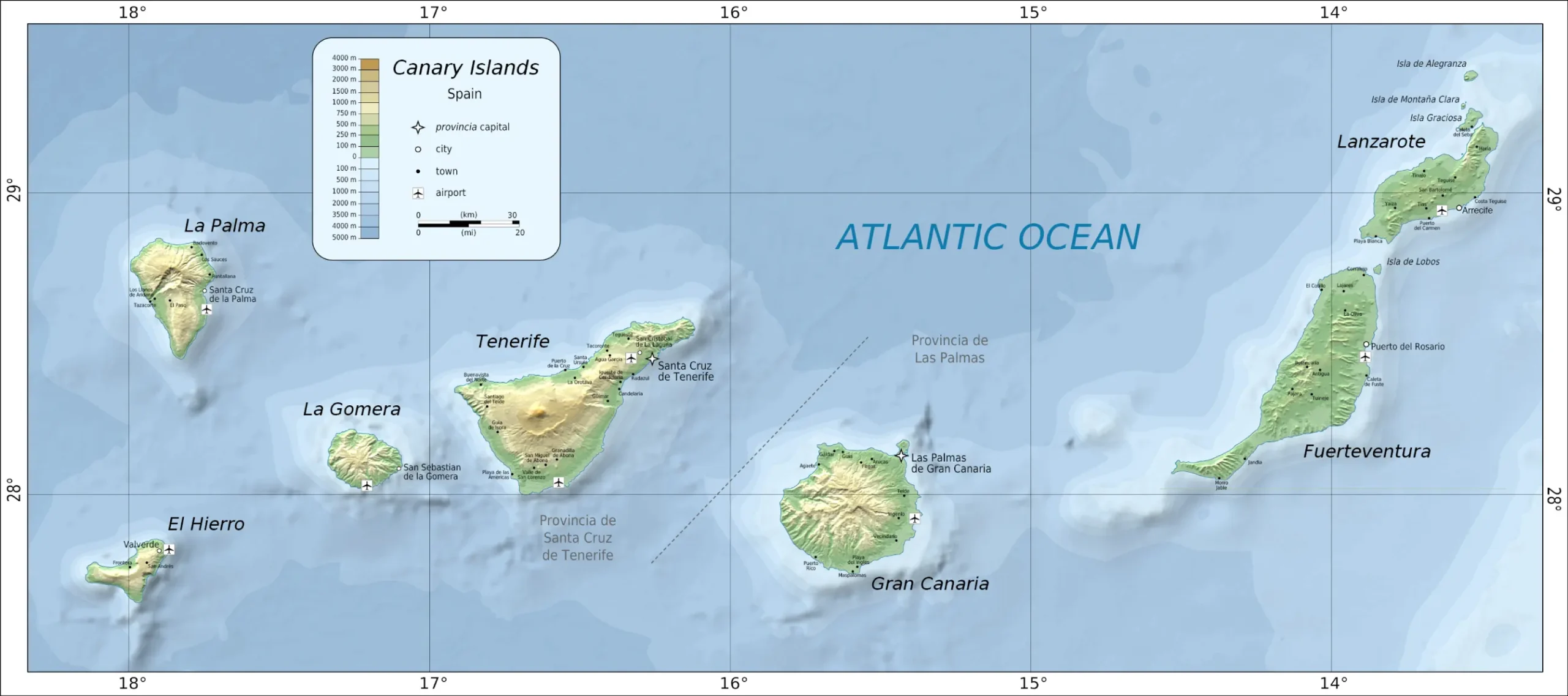
Tenerife is located in the centre of the Canary Islands and is the largest island in the archipelago. It lies in the Atlantic Ocean, about 300 kilometres west of Morocco and Western Sahara, making it part of Macaronesia. The island belongs to the province of Santa Cruz de Tenerife, which includes other islands such as La Palma, La Gomera and El Hierro.
The geographical coordinates of Tenerife are approximately 28 degrees north latitude and 16 degrees west longitude, which gives it a mild climate all year round. The island is about 83 kilometres long from north to south and about 53 kilometres long from east to west, with a total area of about 2,034 square kilometres.
Tenerife is separated from the rest of the Canary Islands by an expanse of water that plays a significant role in shaping its unique climate and sea currents, which favour a rich marine life and a diversity of marine ecosystems. Its proximity to Africa, as well as its geographical isolation, adds to Tenerife’s natural and cultural characteristics that distinguish it from the European part of Spain.
Relief and topography
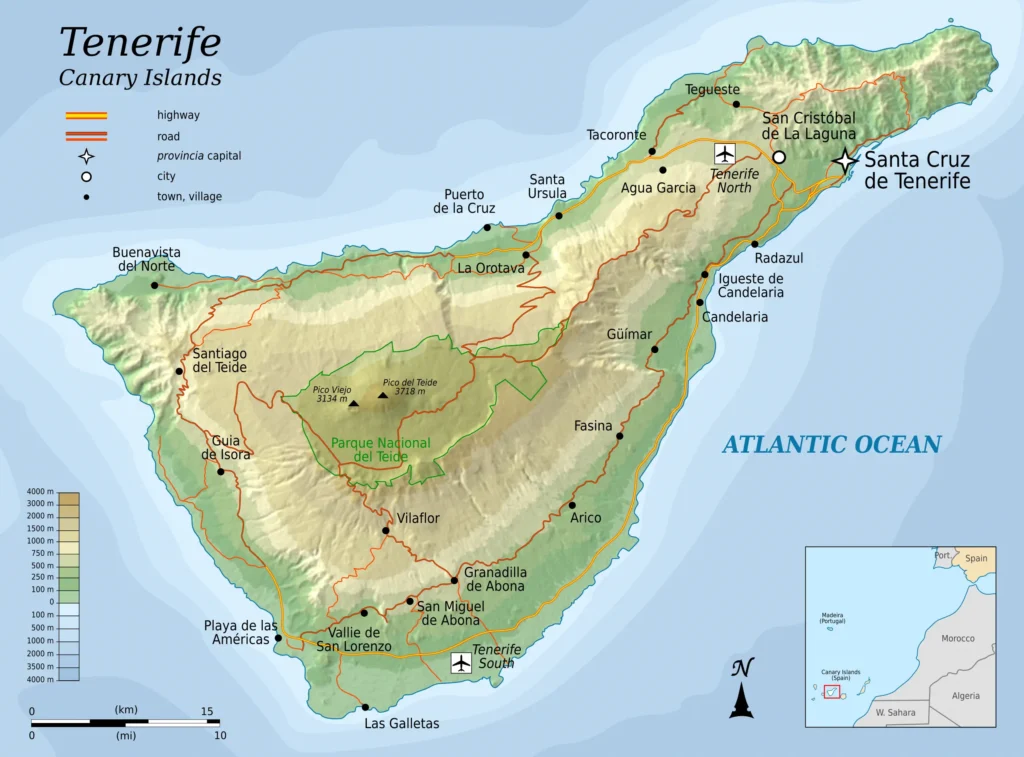
Tenerife is an island of volcanic origin, which significantly determines its topography and relief. Central to the island is the Teide Volcano, which is the highest point in Spain with an elevation of 3,718 metres above sea level. Teide Volcano and the surrounding National Park are not only an important tourist attraction, but also a key element in the geographical structure of the island.
The island of Tenerife is characterised by high mountainousness, with many mountain ranges extending in different directions from the central volcano. These mountain ranges form a variety of microclimates on the island, influencing cloud formation and precipitation in different parts of the island. The topography of the island descends from the central highlands to the lower coastal areas where the main tourist resorts and beaches are located.
Tenerife also has a varied coastline, including high cliffs and extensive sandy beaches, making it a popular destination for sea sports and holidays. The northern coasts of the island are more rocky and precipitous, while the southern coasts are flatter and favourable for swimming and sunbathing.
Tenerife’s topographical diversity creates unique conditions for flora and fauna, and provides exceptional opportunities for tourism and adventure activities, from trekking mountain trails to exploring coastal lagoons.
Climate
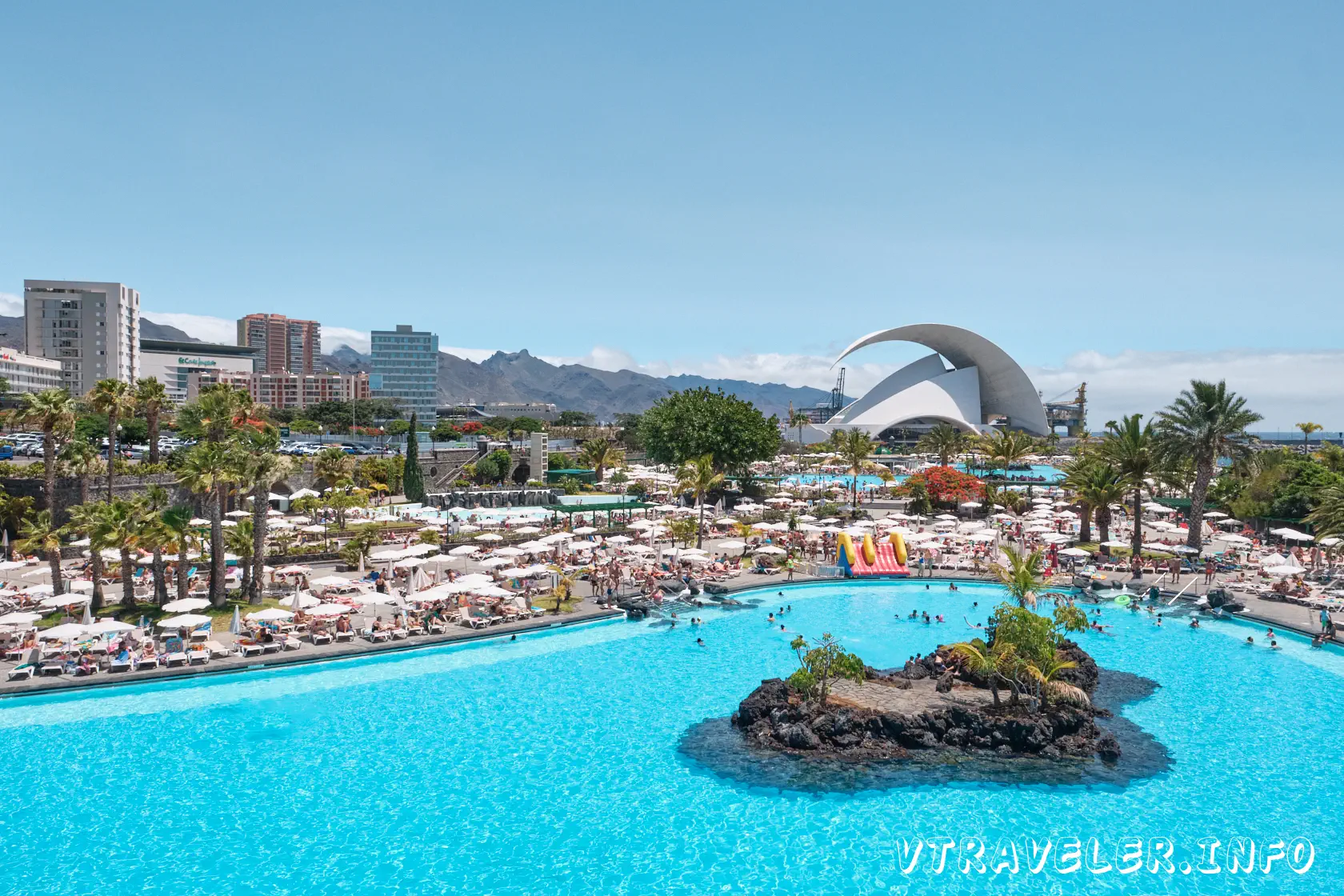
Tenerife’s climate is characterised by considerable diversity, which is why the island is often referred to as the ‘island of eternal spring’. Climate conditions are influenced by several factors: proximity to the equator, ocean currents and the island’s topography.
Tenerife is influenced by the trade winds – constant winds blowing from the north-east that bring coolness and humidity, especially to the northern part of the island. The southern part of the island is protected from these winds by mountain ranges, so the climate is drier and warmer.
The average temperature in Tenerife ranges from 20°C in the winter months to 28°C in the summer months. The island rarely experiences extreme temperatures, thanks to the regulating influence of the ocean, which mitigates climatic fluctuations.
Rainfall on Tenerife is unevenly distributed: in the north of the island it can reach up to 600 mm per year, while in the south it is only around 200 mm. This difference creates diversity in the natural vegetation and farming conditions.
This difference in climatic conditions between the north and south of the island makes Tenerife a unique tourism destination, offering different weather conditions and natural beauty in a relatively small area. This diversity of climate favours the development of different types of holidays, from beach tourism to hiking and excursions on mountain trails.
Hydrography
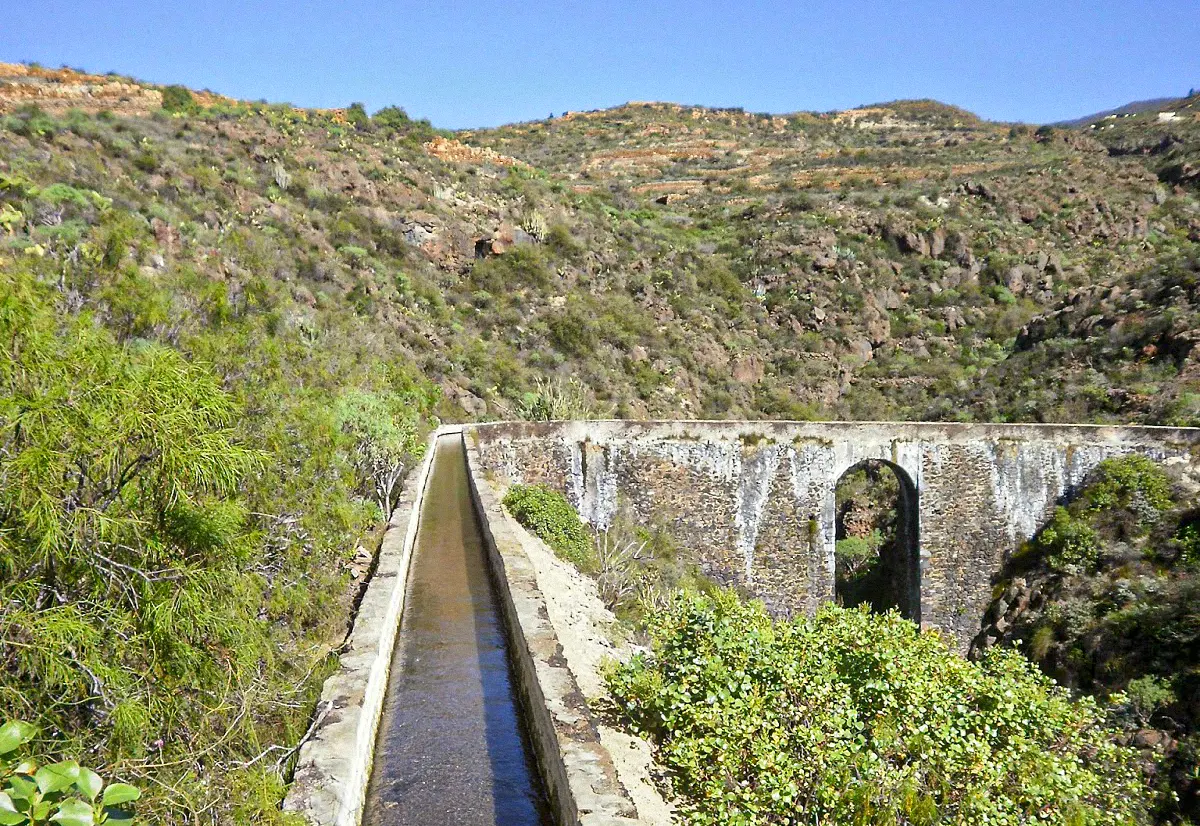
The hydrography of Tenerife is characterised by the island’s water system, where groundwater and small temporary streams called barrancos play a major role. The island has no large rivers or lakes, which is typical of volcanic areas with porous soil that favours the rapid run-off of rainwater.
Tenerife’s groundwater forms an important source of fresh water for the population and agriculture. Water intakes, or so-called galleries (tunnels to intercept the water table), pass through the volcanic rocks to provide access to these waters. These underground springs are often the only fresh water resource in some areas of the island.
Precipitation in Tenerife tends to fall as rain in winter and is more common in the north of the island due to its topography and the effects of the trade winds. This precipitation replenishes underground water reserves and helps to keep the island’s ecosystems moist.
Tenerife’s water resources are also supplemented by the use of reverse osmosis to desalinise seawater, providing an additional source of fresh water for the needs of the population and tourist infrastructure. These technologies play a key role in the sustainable management of the island’s water resources.
Thus, Tenerife’s hydrographic situation is characterised by limited access to natural surface water, compensated for by the development of water extraction and purification technologies, which are critical to sustaining life on the island.
Geology
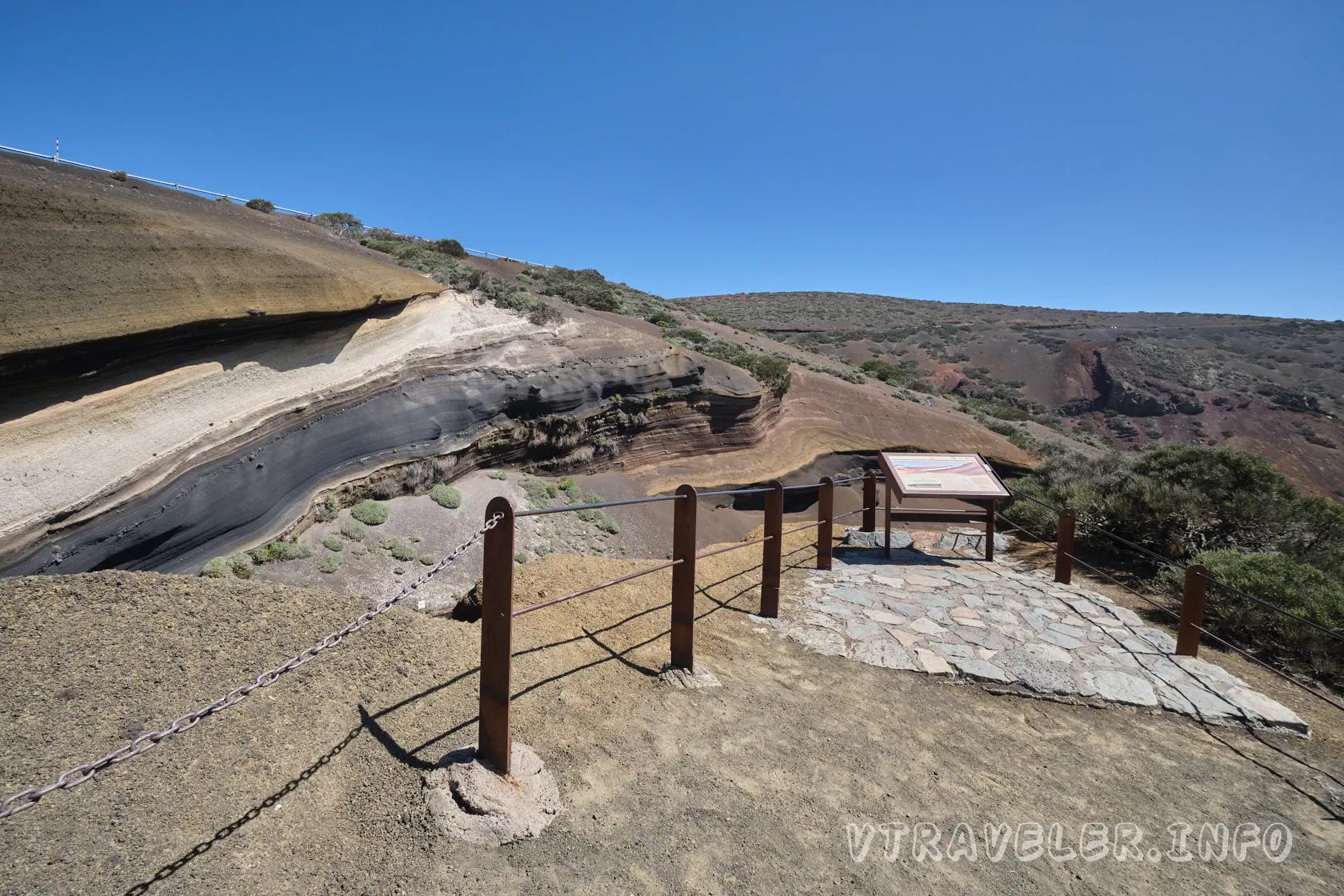
Tenerife is a volcanic island whose geology is defined by millions of years of volcanic activity. The main formation of the island began around 12 million years ago, and since then a succession of eruptions have shaped its modern landscape. The Teide volcano, the centrepiece of the island, is one of the most active volcanoes in the world, with its last major eruption occurring in 1909 (Chinyero).
The island’s geological layers include basalt and trachyte rocks that form its volcanic landscape. These rocks not only create scenic vistas, but also serve as important research sites for studying volcanic processes. The island’s volcanic activity has also contributed to the formation of a variety of minerals and geological formations, including caves and lava tunnels.
Tenerife is characterised by the presence of numerous calderas, large volcanic craters that were formed by the collapse of volcanic peaks or powerful eruptions. The Las Cañadas caldera is one of the most significant and visually impressive and surrounds the Teide volcano, creating a unique and extreme landscape.
The prolonged volcanic activity has had a significant impact on the soil of the island, enriching it with minerals, making the land fertile in some areas, especially suitable for agriculture. This feature also affects the local flora and fauna, providing unique conditions for the development of endemic species.
The geology of Tenerife is key to understanding its natural beauty and diversity, as well as providing invaluable data for scientific research into volcanic activity and the history of the earth’s formation.
Natural zones and biogeography
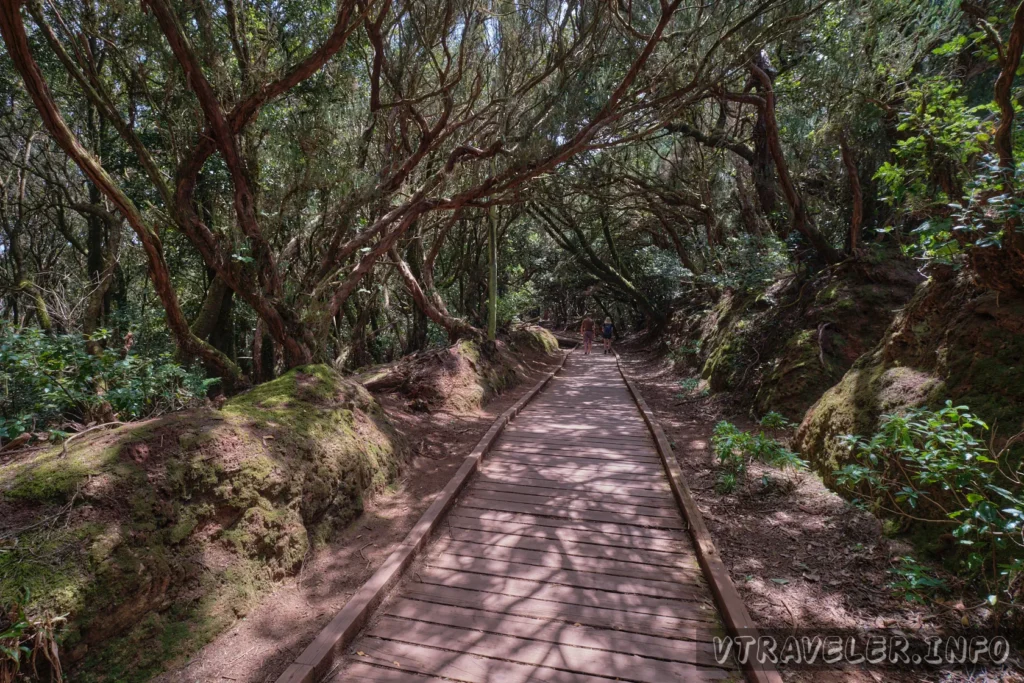
Tenerife has a unique biogeography due to its volcanic origin and diverse climatic conditions. The island’s different natural zones support a wide range of ecosystems, from high-altitude heathlands to humid laurisilvas and coastal mangroves.
Tenerife’s upper-mountain zones are characterised by alpine conditions with limited vegetation and cold-adapted species, such as the high-altitude lavender rose and various species of mosses and lichens. This zone offers unique conditions for studying plant adaptations to extreme temperatures and winds.
Laurisilva is an ancient rainforest located on the northern slopes, where the abundance of rainfall creates ideal conditions for the development of evergreen forests. These forests are home to many endemic plant species such as the canary laurel and the teal tree.
Succulent areas are found in the drier and more arid areas of the island, where water is scarce and where plants such as aloe vera and various species of cacti thrive due to their ability to retain moisture.
Tenerife’s coastal ecosystems include salt marshes and sand dunes, which support a diverse biological flora and fauna adapted to the salty water environment. These areas are critical for breeding and migrating birds such as the grey gull and various species of shorebirds.
The desert and semi-desert zones in the south of Tenerife show a different kind of landscape, dominated by low-growing shrubs and grasses adapted to extremely low rainfall.
These diverse natural zones create a rich mosaic of biogeographical conditions that make Tenerife a valuable destination for ecological research and nature tourism.
Conclusion
Tenerife presents a unique combination of geographical and natural elements that make the island not only a popular tourist destination but also an important site for scientific research. The volcanic origin of the island, the diversity of climatic zones and the richness of biodiversity create an ecosystem where each element plays a role in maintaining a unique natural balance.
Key geographical features such as the high volcano Teide, diverse landscapes from laurisilva to desert zones, and different natural zones from highlands to coastal mangroves emphasise the uniqueness of Tenerife. These features favour the development of industries such as tourism, agriculture and scientific research.
The protection and conservation of Tenerife’s unique nature is a priority for local authorities and the scientific community, ensuring sustainable development and preserving the unique natural heritage for future generations. Understanding and appreciating Tenerife’s geographical and biological diversity is critical to promoting environmental education and ecotourism.
Tenerife remains one of the most fascinating and multifaceted corners of the world, where everyone can find something unique to do, whether it is immersing themselves in exploring its rich geology, enjoying the diversity of flora and fauna or simply relaxing on its many beaches.
Advance Booking
To ensure your hotel availability during your vacation,
book the best offer in advance and enjoy a carefree getaway.
Tenerife Adventures
Discover the multitude of activities and tours available in Tenerife
– book your unique adventure today!

